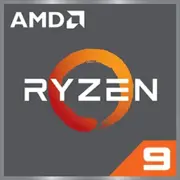AMD Ryzen 9 5900

AMD Ryzen 9 5900: Comprehensive Review of the 2025 Processor
Codename Vermeer, 7nm, 12 Cores, and Flagship Efficiency
Key Specifications: Zen 3, 7nm, and Breakthrough Energy Efficiency
The AMD Ryzen 9 5900 processor, released in 2020, remains a popular choice for budget high-performance builds by 2025. Its Zen 3 architecture (codename Vermeer) delivered a revolutionary IPC (instructions per clock) increase of up to 19% over Zen 2. This is especially noticeable in gaming and single-threaded tasks.
Manufacturing Process and Power Consumption:
- 7nm TSMC process allowed 12 cores and 24 threads to be placed in a compact die.
- Base clock speed—3.0 GHz, with a maximum turbo mode—4.7 GHz.
- TDP 65W—a unique figure for a processor at this level. For example, the competing Intel Core i9-11900K has a TDP of 125W.
Key Features:
- 32MB L3 cache—twice as much as the previous generation Ryzen 3000. Cache reduces latency in games and productivity applications.
- Support for PCIe 4.0—relevant for NVMe drives and graphics cards.
- Energy Efficiency: Even under load, the processor rarely exceeds 80°C with the stock cooler.
Performance:
- In Geekbench 6: 2080 points (single-threaded), 9774 (multi-threaded). For comparison, the Ryzen 7 5800X scores around ~1650/8500 points.
- In games (for instance, Cyberpunk 2077), it delivers stable 90+ FPS in conjunction with the RTX 4070 at Full HD.
Compatible Motherboards: AM4 Socket and Chipsets
The Ryzen 9 5900 uses the AM4 socket, supported by motherboards with the following chipsets:
- B550—optimal choice: PCIe 4.0, memory overclocking up to 5100 MHz (OC), prices from $100 (ASRock B550 Phantom Gaming 4).
- X570—for enthusiasts: more USB ports, enhanced VRM modules (for example, MSI MPG X570 Gaming Plus, $150).
Choosing Tips:
- BIOS update is mandatory for boards released before 2020.
- For maximum stability, choose boards with VRM cooling (minimum 8+2 phases).
Memory: DDR4 and Tuning Tips
The processor does not support DDR5, but works with DDR4:
- Officially: up to 3200 MHz (dual-channel mode recommended).
- In practice: overclocking to 3800-4000 MHz with low timings (CL16-18) provides up to a 10% performance boost in games.
Example Configuration:
- 32 GB (2x16) Kingston Fury Renegade DDR4-3600 CL16 — $90.
Power Supply: Power Calculation
With a TDP of 65W, the Ryzen 9 5900 is among the most "energy-efficient" in its class. Recommendations:
- For systems with an RTX 4060-level graphics card: 500-600W (for instance, Corsair CX650M — $80).
- With top GPUs (RTX 4080/4090): 750-850W (Be Quiet! Straight Power 11 — $140).
Important: Even under peak load, the processor rarely consumes more than 88W.
Pros and Cons: Balancing Power and Limitations
Pros:
- 12 cores for $300 (average price in 2025).
- Low heat output—suitable for compact builds.
- Excellent multi-threaded performance for rendering and streaming.
Cons:
- No integrated graphics—discrete graphics card required.
- Does not support DDR5 and PCIe 5.0.
Use Cases: Gaming, Work, and Beyond
- Gaming: With the RTX 4070 Ti, it achieves 144+ FPS in CS2, 80-90 FPS in Alan Wake 2 on Ultra (1440p).
- Work Tasks: Rendering in Blender is 20% faster than with the Intel Core i7-12700K.
- Multimedia: Streaming in OBS without FPS loss thanks to 24 threads.
Competitor Comparison
- Intel Core i9-11900K (8 cores, 16 threads): Falls short in multi-threaded tasks (Cinebench R23: 15000 vs 21000).
- Intel Core i7-12700K (12 cores, 20 threads): Better in single-threaded benchmarks (+15%), but more expensive ($320 vs $300).
- Ryzen 7 7700X: Supports DDR5, but costs $350 and requires costly AM5 motherboards.
Building Tips
1. Cooling: A tower cooler is sufficient (DeepCool AK400 — $35). For overclocking—Noctua NH-D15 ($90).
2. Motherboard: MSI B550 Tomahawk—a reliable choice at $130.
3. Memory: 32 GB DDR4-3600 CL16—ideal balance.
4. Case: At least 2 fans for ventilation (for example, NZXT H510 Flow — $80).
Final Conclusion: Who Is the Ryzen 9 5900 Suitable For?
This processor is an excellent choice for:
- Gamers who want to save on the CPU and invest in a graphics card.
- Content creators: video rendering, 3D modeling.
- Compact PC enthusiasts: low TDP allows building a powerful system in a Mini-ITX case.
Priced at $300, it offers a cost-effective alternative to new models, especially if DDR5 and PCIe 5.0 are not priorities. In 2025, the Ryzen 9 5900 remains a reliable workhorse for those who value a balance of price and performance.
Basic
CPU Specifications
Memory Specifications
GPU Specifications
Miscellaneous
Benchmarks
Compared to Other CPU
Share in social media
Or Link To Us
<a href="https://cputronic.com/cpu/amd-ryzen-9-5900" target="_blank">AMD Ryzen 9 5900</a>